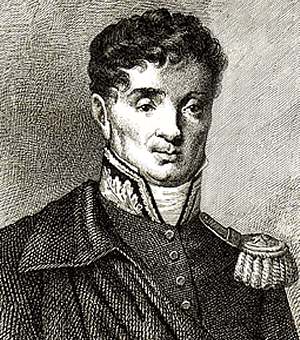<Back to Index>
- Hypnotist Armand - Marie - Jacques de Chastenet, Marquis de Puységur, 1751
PAGE SPONSOR

Armand - Marie - Jacques de Chastenet, Marquis de Puységur (1751 - 1825), was a French aristocrat from one of the most illustrious families of the French nobility. He is now remembered as one of the pre - scientific founders of hypnotism (a branch of animal magnetism, or Mesmerism).
The Marquis de Puységur learned about Mesmerism from his brother Antoine - Hyacinthe, the Count of Chastenet. One of his first and most important patients was Victor Race, a 23 year old peasant in the employ of the Puységur family. Race was easily magnetized by Puységur, but displayed a strange form of sleeping trance not before seen in the early history of Mesmerism.
Puységur noted the similarity between this sleeping trance and natural sleep - walking or somnambulism, and he named it "artificial somnambulism". Today we know similar states by the name "hypnosis", although that term was invented much later by James Braid in 1842. Some characteristics of Puysegur's artificial somnambulism were in any case specific of his method.
Puységur rapidly became a highly successful magnetist, to whom people came from all over France. In 1785, Puységur taught a course in animal magnetism to the local Masonic society, which he concluded with these words:
I believe in the existence within myself of a power.
From this belief derives my will to exert it.
The entire doctrine of Animal Magnetism is contained in the two words: Believe and Want.
I believe that I have the power to set into action the vital principle of my fellow - men;
I want to make use of it; this is all my science and all my means.
Believe and want, Sirs, and you will do as much as I.— Marquis de Puységur
Puységur's institute for training in animal magnetism, Société Harmonique des Amis Réunis, grew rapidly until the Revolution in 1789. During the revolutionary era the institute was disbanded and Puységur spent two years in jail. After the Napoleons' overthrow the new generation of practitioners, of mesmerists (and later of hypnotists) looked to Puységur as their patriarch, and came to accept his method of inducing a sleeping trance in preference to the original methods of Mesmer. Puységur, however, always portrayed himself as a faithful disciple of Mesmer, and never took credit for having invented the procedure that is now known as hypnotic induction. His contributions were gradually forgotten, until Nobel prize Charles Richet rediscovered his writings in 1884, and showed that most of what other people had claimed as their discoveries in the field of magnetism and hypnotherapy were originally due to the Marquis de Puységur.
Henri Ellenberger, the great historian of psychoanalysis and psychotherapy, wrote that Puységur was "one of the great forgotten contributors to the history of the psychological sciences." The details of the life and work of Puységur may be found in Ellenberger's book, The Discovery of the Unconscious.